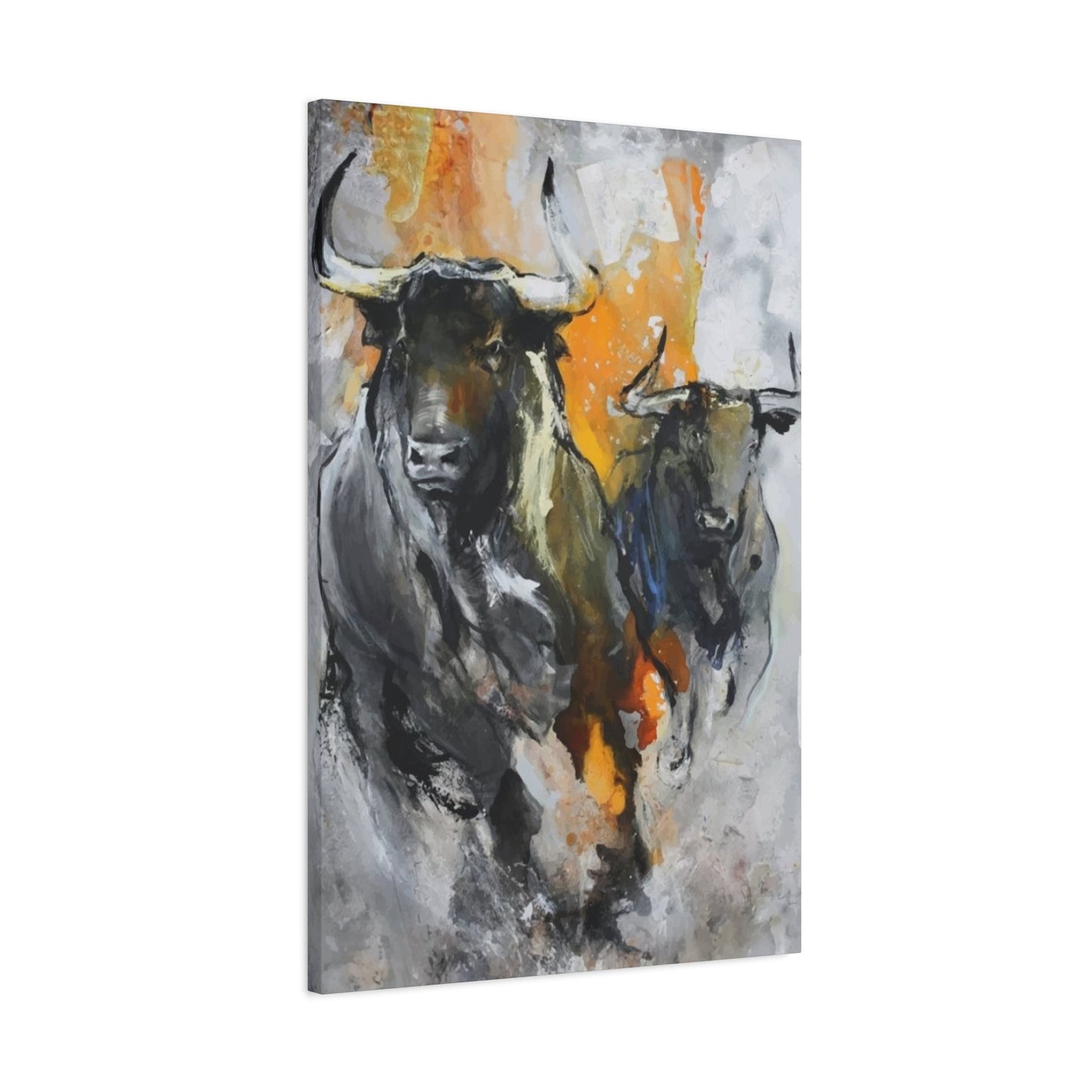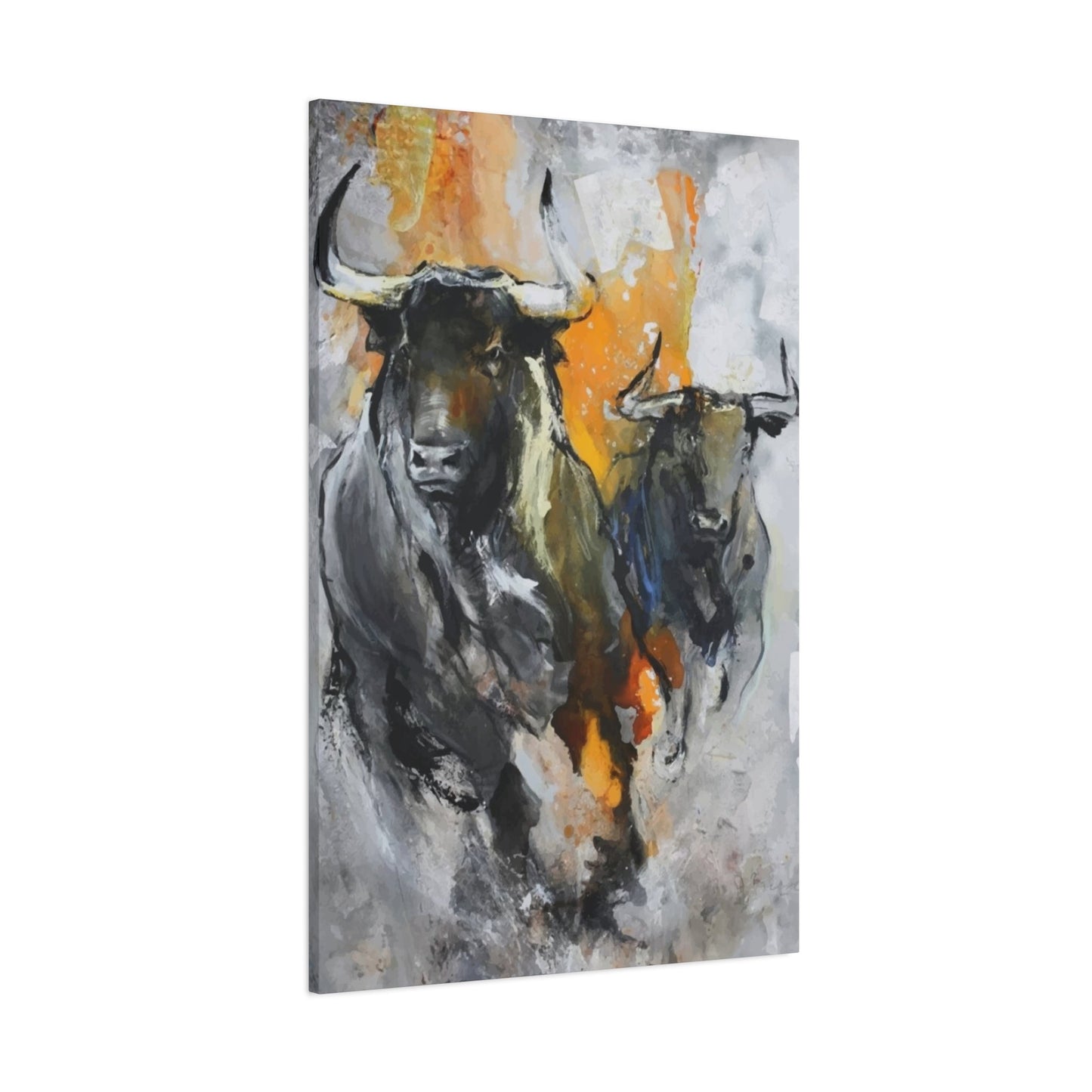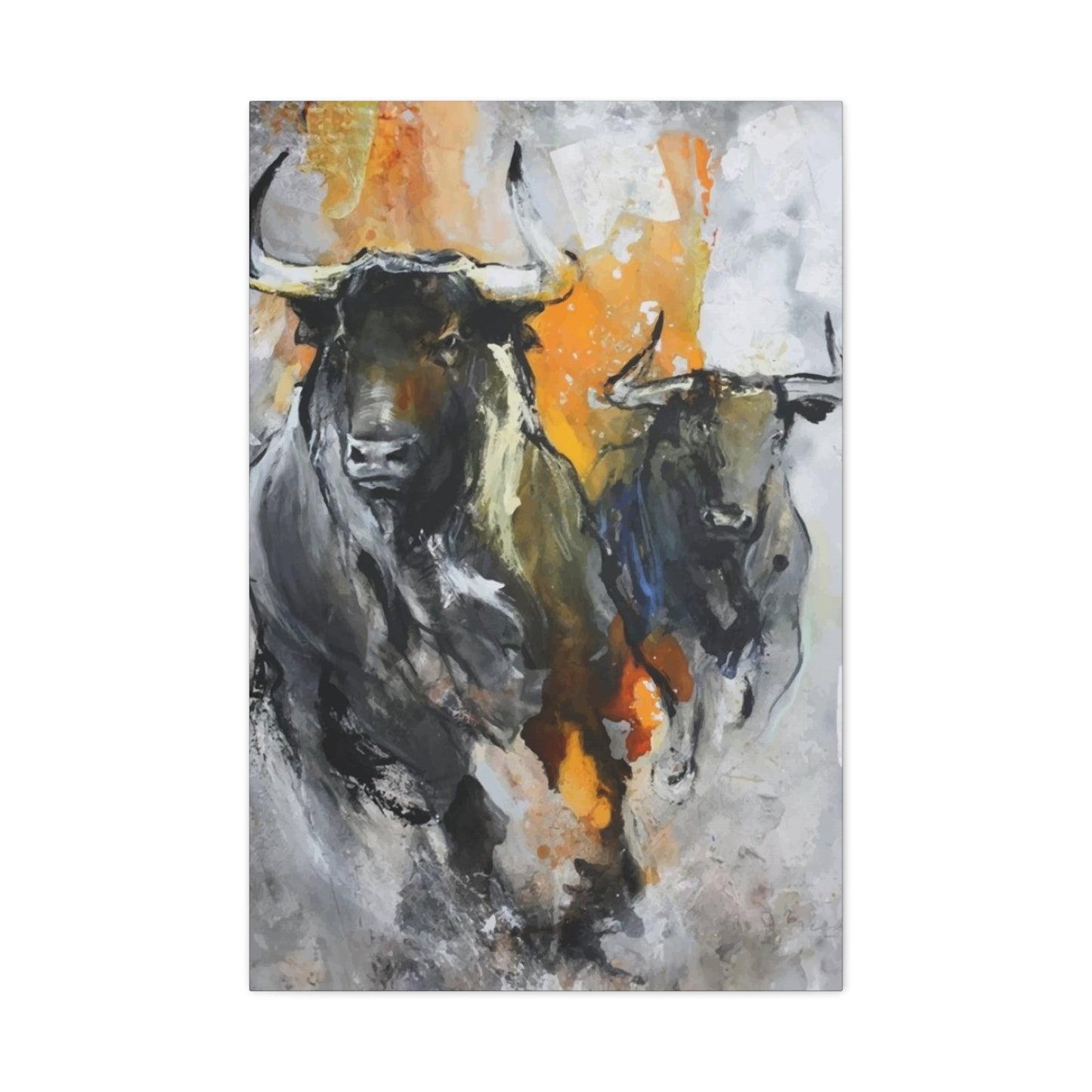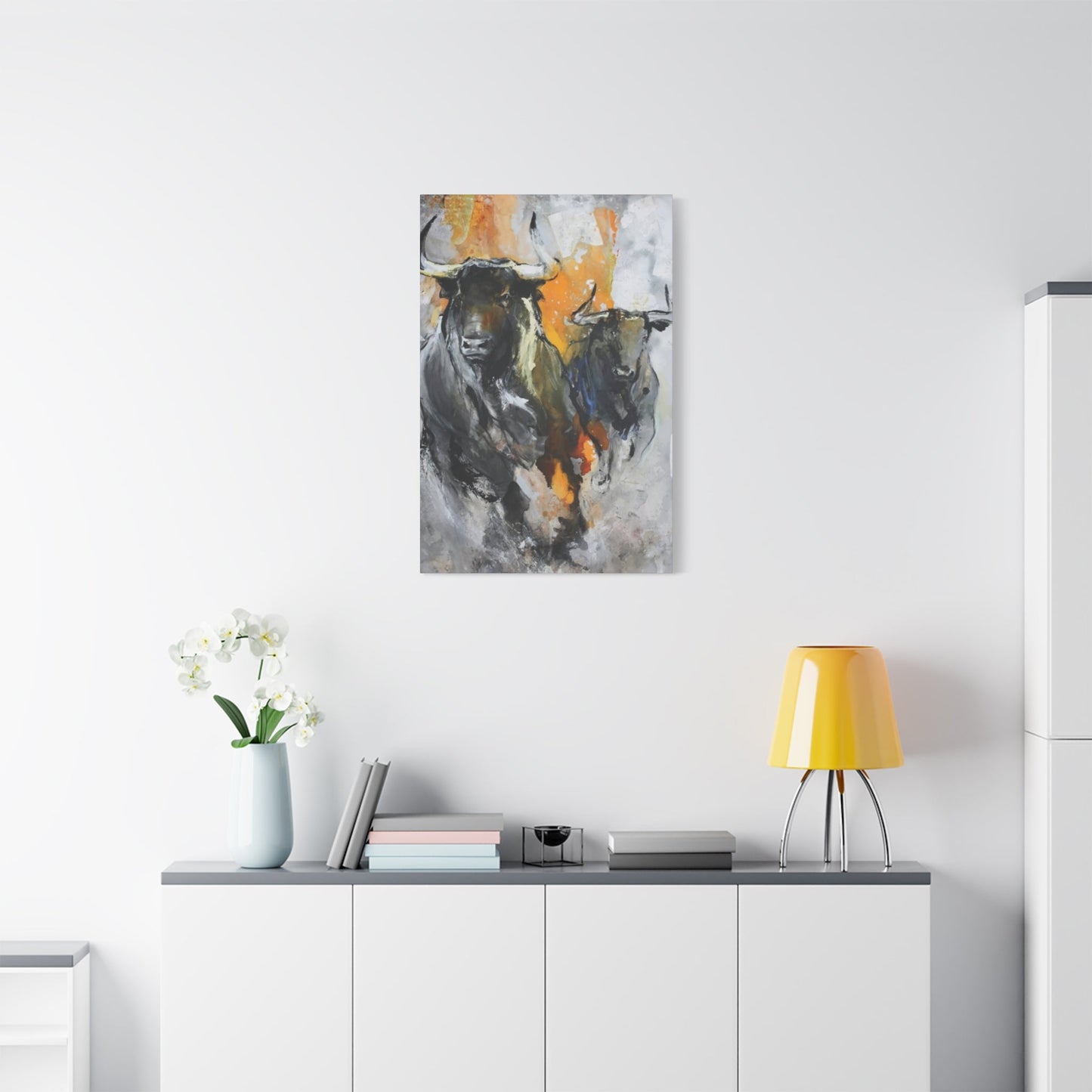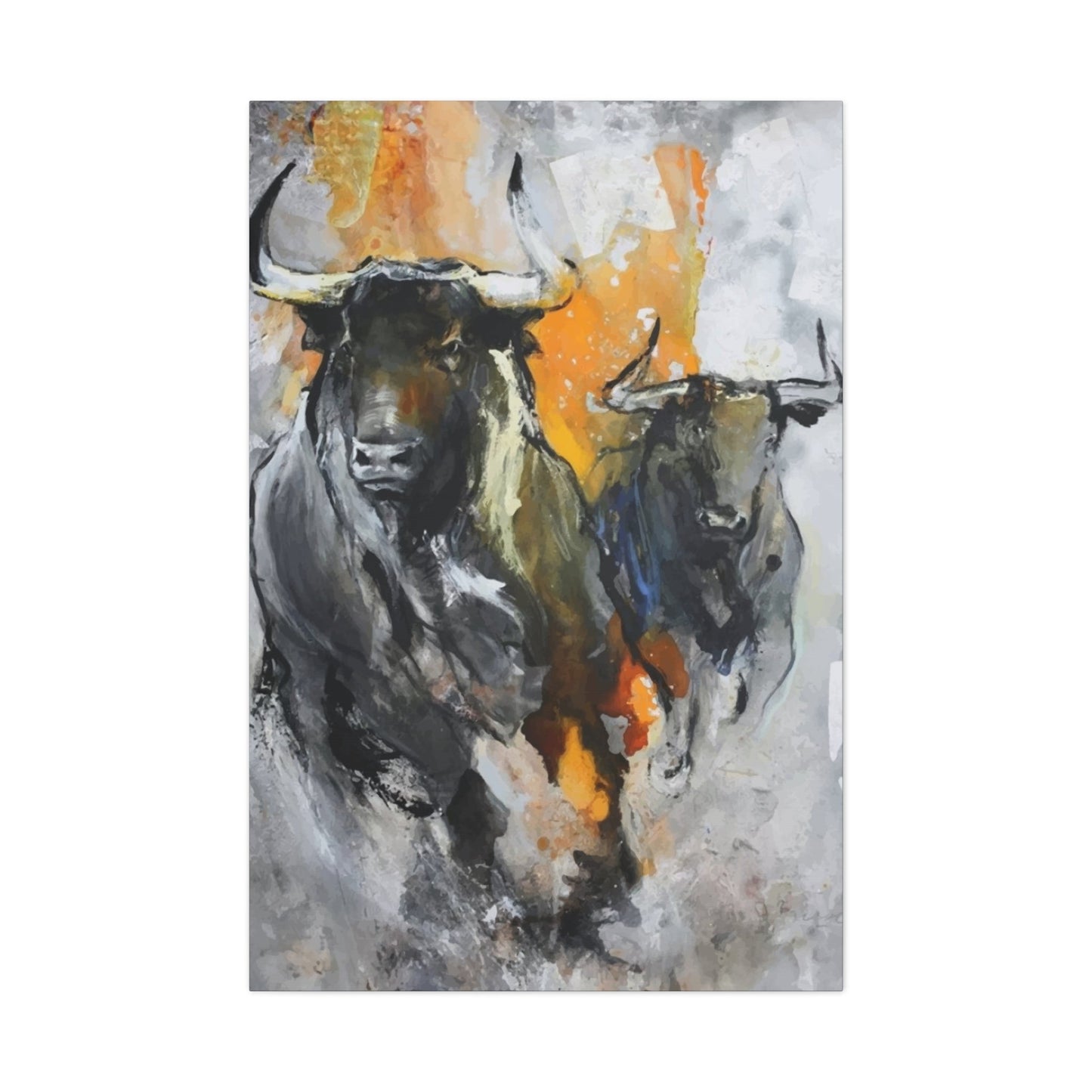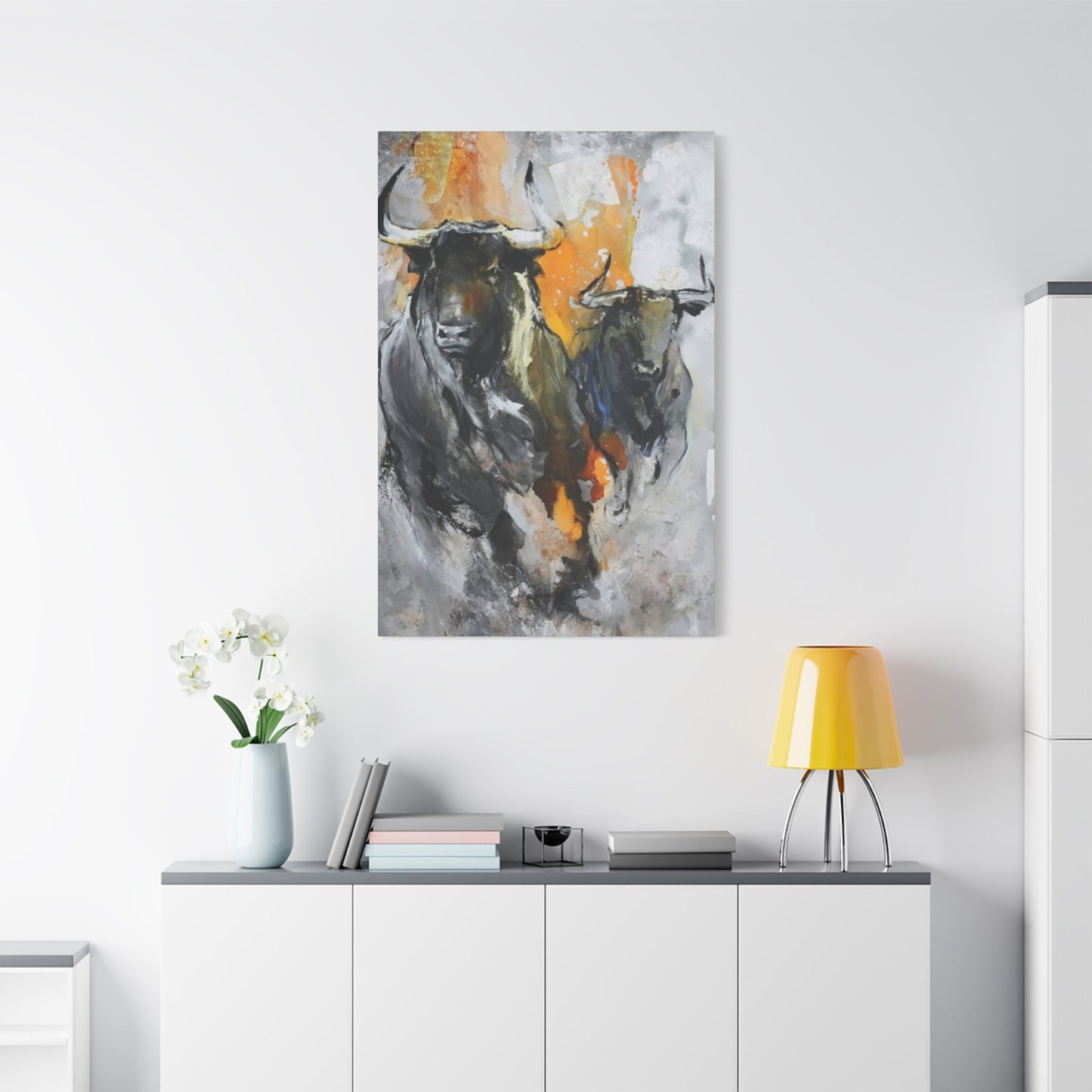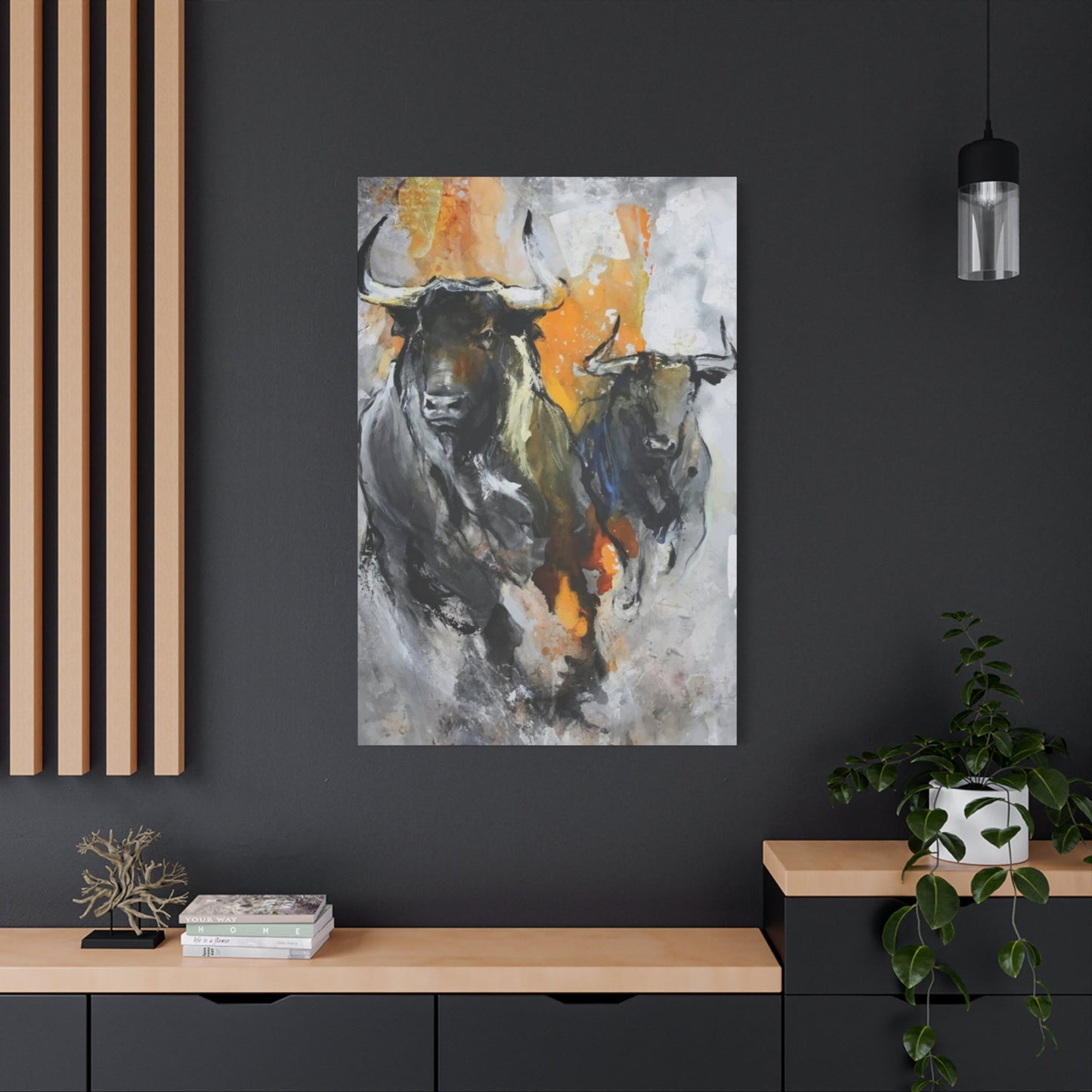Two Bulls Wall Art: Enhancing Your Interior Spaces with Powerful Animal Imagery
The visual impact of animal imagery in interior design has captivated homeowners and designers for generations. Among the most compelling subjects for wall decoration are depictions of bulls, particularly paired compositions that showcase these magnificent creatures in their natural grandeur. The presence of dual bull imagery creates an atmosphere of vitality, determination, and raw natural beauty that few other decorative elements can match. This comprehensive exploration delves into the multifaceted world of bovine artwork, examining how these powerful representations can transform residential and commercial spaces into environments that resonate with character, strength, and timeless appeal.
The symbolism inherent in bull imagery transcends mere decoration, tapping into ancient cultural associations that span civilizations and centuries. From the sacred cattle of ancient Egypt to the revered oxen of Asian traditions, bulls have represented fertility, abundance, prosperity, and unwavering determination. When incorporated into modern interiors, these symbolic associations continue to resonate, creating spaces that feel grounded, purposeful, and connected to enduring natural forces. The decision to feature paired bulls rather than a single animal amplifies these meanings, suggesting partnership, balance, and the complementary forces that drive progress and achievement.
Strength on Your Walls
Incorporating imagery of powerful animals into living spaces creates an immediate psychological impact that extends beyond aesthetic appreciation. The presence of bull artwork establishes a visual anchor that commands attention and sets the emotional tone for an entire room. These creatures, captured in moments of intensity or calm repose, bring an element of the untamed natural world into controlled domestic environments, creating a fascinating contrast that enriches daily experience.
The psychological effects of viewing animal strength represented in art form have been documented across multiple studies in environmental psychology. Spaces decorated with powerful animal imagery tend to inspire feelings of confidence, determination, and resilience in their occupants. When guests enter a room adorned with striking bull artwork, they immediately perceive the values and character of the homeowner, creating an instant connection before any words are exchanged. This non-verbal communication through design choices makes animal artwork particularly valuable in spaces where first impressions matter significantly.
The physical presence of bulls, even when represented in two-dimensional form, carries substantial visual weight. Their muscular forms, prominent horns, and solid stance create compositional elements that anchor interior design schemes effectively. Unlike delicate or ethereal subjects, bull imagery provides grounding energy that balances lighter elements in a room, creating overall harmony while maintaining visual interest. The interplay of light and shadow across their powerful forms adds depth and dimension to walls that might otherwise feel flat or unengaging.
Placement considerations for powerful animal artwork require thoughtful attention to sight lines, lighting conditions, and spatial flow. The most effective installations position these commanding images where they can be appreciated from multiple vantage points without overwhelming the space. Entry areas, living rooms, and home offices particularly benefit from the inspirational qualities of bull imagery, though appropriate scaling and framing ensure these pieces enhance rather than dominate their surroundings. The goal remains creating spaces that feel both energized and comfortable, impressive yet inviting.
Bold Two Bulls Canvas Prints
Canvas printing technology has revolutionized the accessibility and quality of animal artwork for contemporary interiors. This medium offers distinct advantages over traditional paper prints or photographic reproductions, providing texture, depth, and durability that align perfectly with the robust nature of bull imagery. The fabric surface of canvas creates a tactile dimension that invites closer inspection while withstanding the test of time in ways that paper-based alternatives cannot match.
The production process for quality canvas prints begins with high-resolution digital files that capture every nuance of color, texture, and detail in the original image. Advanced printing techniques employ archival-quality inks that resist fading even when exposed to indirect sunlight, ensuring that the vivid colors and dramatic contrasts of bull imagery remain vibrant for years. The stretching process, whereby canvas is wrapped around wooden frames, creates a three-dimensional object that projects slightly from the wall, adding architectural interest to flat surfaces.
Modern canvas prints eliminate the need for additional framing in many applications, offering a clean, contemporary presentation that suits various interior styles. The gallery-wrap technique, where the image continues around the sides of the stretcher bars, creates a finished appearance from any viewing angle. This frameless presentation works particularly well with bold subjects like bulls, allowing the imagery itself to command full attention without the distraction of decorative borders or matting.
Color saturation capabilities in contemporary canvas printing bring bull imagery to life with remarkable fidelity. The earthy tones of brown, black, and tan that characterize these animals reproduce beautifully on canvas, while the subtle variations in hide texture and the gleaming highlights on horns and eyes achieve photographic realism. Whether depicting bulls in golden sunset light or dramatic storm conditions, canvas prints capture atmospheric qualities that immerse viewers in the scene, creating emotional connections that transcend mere decoration.
Size options in canvas printing range from modest accent pieces to dramatic statement installations spanning entire walls. Multi-panel compositions, known as diptychs, triptychs, or larger polyptychs, allow for expansive presentations of dual bull imagery that can transform spacious rooms into gallery-like environments. These segmented installations create visual rhythm through the spaces between panels while maintaining compositional unity across the complete work, offering design flexibility that accommodates various architectural features and furniture arrangements.
Rustic Decor Featuring Two Bulls
The aesthetic movement toward rustic interior design has gained tremendous momentum in recent years, driven by desires to create homes that feel warm, authentic, and connected to natural materials and simpler times. Bull imagery aligns perfectly with this design philosophy, embodying the agricultural heritage and connection to land that rustic style celebrates. Incorporating dual bull artwork into rustic spaces amplifies the stylistic coherence while adding visual focal points that anchor the overall design scheme.
Rustic interiors typically feature natural materials including reclaimed wood, natural stone, leather, and wrought iron. These textural elements create environments that feel grounded and substantial, qualities that bull imagery reinforces through subject matter and composition. The pairing of weathered wood accent walls with canvas prints depicting bulls creates a harmonious visual dialogue between materials and imagery, each element strengthening the impact of the others. The result is spaces that feel cohesive and intentional rather than randomly assembled.
Color palettes in rustic design tend toward earth tones, muted neutrals, and the occasional accent of deeper jewel tones or faded primary colors. Bull artwork naturally complements these schemes through the inherent coloring of the animals themselves and the landscapes they typically inhabit. Images capturing bulls against backgrounds of golden prairie grass, weathered barn wood, or stormy skies introduce color variation while maintaining the overall tonal harmony essential to successful rustic design. The visual weight of the animals provides necessary contrast against lighter backgrounds without disrupting the peaceful atmosphere rustic spaces aim to achieve.
Furniture selections in rustic interiors often include substantial pieces with visible wood grain, distressed finishes, and simple, sturdy construction. These solid, unpretentious furnishings pair beautifully with equally straightforward bull imagery. Avoiding overly ornate frames or elaborate mounting systems allows the artwork to integrate seamlessly into the space, appearing as a natural extension of the design philosophy rather than a competing element. Simplicity in presentation honors both the subject matter and the surrounding aesthetic.
Lighting design plays a crucial role in bringing rustic spaces to life while properly showcasing featured artwork. Warm-toned lighting, whether from vintage-inspired fixtures, exposed Edison bulbs, or strategically placed accent lamps, creates the inviting glow that defines successful rustic interiors. When directed toward bull artwork, this warm illumination enhances the natural tones of the animals while casting subtle shadows that emphasize their muscular forms. The interplay of light and shadow across canvas texture adds another layer of visual interest that changes throughout the day as natural light shifts.
Powerful Two Bulls Wall Art Ideas
Creative approaches to displaying dual bull imagery extend far beyond simply hanging a single canvas print. Thoughtful design explorations reveal numerous possibilities for incorporating this powerful subject matter into diverse interior contexts. These innovative applications demonstrate how flexible and adaptable bull artwork can be when approached with imagination and attention to spatial characteristics.
Gallery wall configurations offer opportunities to combine bull imagery with complementary elements that expand the visual narrative. Pairing a central dual bull canvas with smaller supporting pieces depicting ranch landscapes, vintage agricultural tools, or abstract representations of natural textures creates a curated collection that tells a broader story. The bulls serve as the focal point around which supporting elements orbit, creating visual hierarchy while maintaining compositional balance. This approach works exceptionally well in larger spaces where a single piece, regardless of size, might feel insufficient to fill available wall area.
Layered installations introduce dimensional variation by positioning bull artwork at different depths from the wall surface. Mounting one canvas slightly forward of another, or incorporating three-dimensional elements like sculptural brackets or shadow boxes alongside flat artwork, creates depth that engages viewers and invites exploration from multiple viewing angles. These layered compositions transform walls into dynamic architectural features rather than simple display surfaces, adding sophistication to straightforward subject matter.
Corner installations take advantage of often-underutilized spaces by wrapping dual bull imagery around adjoining walls. This approach creates immersive experiences where viewers feel surrounded by the imagery rather than simply viewing it from a distance. Corner placements work particularly well in open-concept spaces where traditional wall arrangements might interrupt sight lines or interfere with furniture placement. The angular presentation adds visual interest while solving practical design challenges.
Oversized installations that span from floor to ceiling or stretch across entire walls make dramatic statements appropriate for commercial spaces, grand residential rooms, or anywhere bold design gestures are desired. These large-scale presentations transform bull imagery from decorative accent to architectural feature, fundamentally altering the spatial experience. The technical challenges of mounting such substantial pieces require professional installation, but the resulting impact justifies the additional investment and effort.
Backlit installations introduce an entirely different dimension to canvas art by positioning LED lighting behind semi-transparent materials. While traditional canvas may not lend itself to backlighting, alternative materials can create glowing presentations of bull imagery that serve dual functions as artwork and ambient lighting. These innovative applications suit contemporary spaces where traditional approaches might feel too conventional or expected.
Two Bulls in Motion: Canvas Prints
The depiction of movement in static imagery has challenged and inspired artists throughout history. Capturing bulls in moments of action brings dynamic energy to canvas prints that static poses cannot match. Whether charging, running, fighting, or simply walking across pasture land, bulls in motion convey vitality and power that resonates deeply with viewers, creating artwork that feels alive and immediate.
Photographic techniques for capturing animal movement have evolved dramatically with advances in camera technology. High-speed shutters freeze moments of incredible detail, revealing muscle tension, airborne dust, and expressions of focused intensity that would be invisible to the naked eye during real-time observation. These frozen moments of peak action create compelling compositions that draw viewers into the scene, imagining the sounds, smells, and energy of the moment just before and after the captured instant.
The compositional challenges of depicting movement require careful attention to visual flow and directional cues. Effective action shots position moving bulls in ways that suggest trajectory and momentum, typically placing them entering the frame rather than exiting to avoid creating compositions that feel unfinished or unbalanced. The placement of supporting elements like flying dirt, streaming water, or displaced grass reinforces the sense of motion while adding contextual detail that grounds the image in believable reality.
Blur effects, when applied judiciously, can enhance the perception of speed and power in animal imagery. Selectively blurring backgrounds while maintaining sharp focus on the primary subjects creates a sense of rapid movement through space. This technique, borrowed from sports photography, effectively conveys velocity and urgency while keeping the bulls themselves clearly recognizable and visually dominant. The contrast between sharp and blurred areas guides viewer attention precisely where the artist intends.
Multiple-exposure techniques that show successive positions of moving animals create unique artistic effects that suggest the passage of time within a single image. Though less common in contemporary canvas prints, these stylized approaches offer alternatives to straightforward photographic realism, appealing to viewers who appreciate more interpretive artistic expressions. The repetition of forms across the composition creates rhythmic patterns that please the eye while clearly communicating motion and energy.
Western Style: Two Bulls on Canvas
Western design aesthetic draws from the cultural heritage of the American frontier, incorporating elements that evoke cowboys, ranches, wide-open spaces, and the rugged individualism that characterized westward expansion. Bull imagery fits naturally into this stylistic framework, representing the livestock that formed the economic foundation of western settlement and the untamed wildness that early settlers encountered. Contemporary interpretations of western style range from historically accurate recreations to stylized modern takes that reference rather than replicate traditional forms.
Authentic western interiors feature materials and objects with genuine historical connections to frontier life. Leather furniture, wrought iron hardware, Native American textiles, and wagon wheel accents create environments that transport occupants to earlier eras. Bull artwork in these contexts should reflect appropriate aesthetic sensibilities, avoiding overly modern treatments or artistic styles that would feel anachronistic. Sepia tones, high-contrast black and white compositions, or warm color palettes that suggest aged photographs maintain historical coherence while providing visual interest.
Modern western design takes a lighter approach, incorporating western motifs into contemporary contexts through selective accent pieces rather than comprehensive thematic immersion. In these spaces, bull artwork serves as a clear style indicator without requiring every element in the room to reinforce the western theme. Clean-lined furniture, neutral color schemes, and minimal accessories allow a striking dual bull canvas to establish the stylistic direction without overwhelming the space with competing visual information. This restrained approach suits contemporary sensibilities while honoring western heritage.
Color treatments in western-themed bull artwork significantly impact the overall mood and stylistic coherence. Traditional warm tones including rich browns, deep reds, turquoise accents, and sunset golds create unmistakably western atmospheres. More contemporary interpretations might employ cooler palettes, metallic accents, or unexpected color combinations that maintain thematic connection to western imagery while offering fresh visual perspectives. The choice between traditional and contemporary color treatments should align with the overall design direction of the space.
Scale and proportion considerations in western-themed spaces often favor bold, substantial elements that match the expansive landscapes that inspired the style. Undersized artwork can feel tentative and ineffective in rooms decorated with large furniture pieces and dramatic architectural features. Generous sizing for bull canvas prints ensures they hold their own within the design composition, creating the confident, assured atmosphere that defines successful western interiors.
Two Bulls for Farmhouse Interiors
The farmhouse design aesthetic has surged in popularity, driven partly by prominent media personalities and design influencers who have demonstrated the style's versatility and broad appeal. This approach to interior design emphasizes comfort, functionality, and connection to agricultural heritage, creating spaces that feel welcoming, unpretentious, and family-oriented. Bull artwork complements farmhouse interiors beautifully, reinforcing themes of rural life, honest labor, and appreciation for the animals that have historically supported agricultural communities.
Shiplap walls, exposed ceiling beams, apron-front sinks, and open shelving define the visual language of farmhouse style. These architectural elements create textural interest and visual complexity that provides excellent backdrops for carefully chosen artwork. Bull canvas prints positioned against white or light-colored shiplap walls pop dramatically, the contrast between dark animals and bright backgrounds creating immediate visual impact. The horizontal lines of shiplap add subtle directional movement that can either complement or contrast with the orientations of bulls in the artwork, depending on desired effects.
The modern farmhouse movement has introduced more refined and polished interpretations of traditional farmhouse elements. Cleaner lines, more sophisticated color palettes, and careful editing of decorative elements create spaces that feel fresh and current while maintaining connections to farmhouse heritage. In these updated contexts, bull artwork should similarly balance traditional subject matter with contemporary presentation. High-quality printing, professional mounting, and thoughtful placement ensure that even agricultural subjects feel appropriate in refined settings.
Mixing metals, woods, and textiles creates the layered, collected-over-time appearance that characterizes authentic farmhouse style. Bull artwork becomes part of this curated collection rather than standing apart as a formal art statement. Positioning canvas prints among family photographs, vintage signs, and functional objects like baskets and crocks creates visual narratives that suggest personal history and meaningful connections rather than merely decorative choices. This integration of artwork into broader collections makes spaces feel lived-in and genuine.
Seasonal decorating opportunities abound in farmhouse-styled spaces, with many homeowners regularly updating accessories to reflect changing seasons and holidays. Bull artwork can serve as a year-round constant around which seasonal elements rotate, providing visual stability while allowing for regular refreshment of the overall look. The neutral tones and timeless subject matter of bull imagery pair equally well with spring flowers, summer greenery, autumn pumpkins, or winter evergreens, demonstrating remarkable versatility across seasonal themes.
Animal Strength Captured: Two Bulls Art
The fascination with depicting animal power in artistic form extends back to the earliest human creative expressions. Cave paintings featuring aurochs and bison demonstrate that even prehistoric peoples found meaning in representing the strong animals they encountered in their environments. This ancient tradition continues in contemporary bull artwork, which channels millennia of human relationship with these powerful creatures into forms accessible to modern viewers.
Wildlife photography as an artistic discipline requires exceptional patience, technical skill, and deep understanding of animal behavior. Capturing compelling images of bulls demands all these qualities plus physical courage, as photographing large animals at close range involves genuine danger. The resulting images carry authenticity and immediacy that staged or manipulated photographs cannot replicate, creating connections between viewers and subjects that feel genuine and emotionally resonant.
The ethical considerations surrounding wildlife photography have become increasingly prominent as awareness grows regarding human impact on animal habitats and behaviors. Responsible photographers maintain respectful distances, avoid actions that stress or endanger animals, and refuse to manipulate natural behaviors for improved shots. When selecting bull artwork for interior spaces, supporting photographers who practice ethical wildlife documentation ensures that the beauty displayed on walls did not come at the expense of animal welfare.
Compositional techniques for emphasizing strength in animal photography include low camera angles that present subjects from perspectives suggesting power and dominance. Shooting upward toward bulls creates imposing silhouettes that fill frames and tower over viewers, psychological effects that translate effectively into printed artwork. Tight cropping that focuses on muscular details, powerful legs, or intense facial expressions similarly emphasizes physical capability and latent energy.
Lighting conditions dramatically affect the perception of strength in animal imagery. Harsh, directional light creates strong shadows that emphasize musculature and form, while softer, diffused light might minimize these physical attributes. Storm light, with its dramatic contrast between dark clouds and bright breaks, adds emotional intensity that amplifies the inherent power of bull subjects. Golden hour lighting wraps animals in warm glows that soften aggressive edges while maintaining the fundamental impression of substantial physical presence.
Dynamic Two Bulls Wall Decor
Creating truly dynamic wall presentations requires moving beyond single-piece installations toward more complex arrangements that create visual movement and sustained interest. Dynamic compositions draw the eye across surfaces, encouraging extended viewing and repeated appreciation. When working with bull imagery, dynamic arrangements can tell visual stories, create dramatic focal points, or establish rhythmic patterns that enliven entire walls.
Asymmetrical balance in wall arrangements creates visual tension that engages viewers more actively than perfectly symmetrical layouts. Positioning a large bull canvas off-center and balancing its visual weight with smaller complementary elements on the opposite side creates compositions that feel deliberate and sophisticated. This approach requires careful attention to the relative visual weights of different elements, considering not just physical size but also color intensity, subject matter complexity, and frame treatments.
Vertical stacking of related images creates tall, column-like arrangements that draw the eye upward, emphasizing ceiling height and creating impressions of grandeur in modestly sized rooms. A vertical arrangement featuring bulls at different scales or in different poses tells visual stories of growth, relationship, or sequential action. The spaces between stacked elements should be consistent and proportional to frame sizes, creating rhythmic patterns that feel intentional rather than random.
Diagonal arrangements introduce dynamic movement across wall surfaces, suggesting action and energy appropriate to powerful animal subjects. Staggering canvas positions along diagonal lines creates the impression of ascent or descent, movement across landscapes, or the passage of time. These angled arrangements work particularly well on walls adjacent to stairways, where the diagonal already established by stairs continues into the artwork arrangement.
Three-dimensional mounting techniques that project canvas prints forward from walls at varying depths create shadow patterns that change throughout the day as lighting conditions shift. These dimensional variations add sculptural qualities to flat artworks, creating installations that reward viewing from multiple angles and at different times. The play of natural light across stepped surfaces introduces temporal elements to static images, ensuring that the artwork presents differently in morning light than in evening glow.
Two Bulls: Perfect for Entryways
First impressions establish emotional tones for entire home experiences, making entryway design particularly important for overall interior success. The entry serves as a transition zone between public and private realms, and the decorative choices made in this space communicate volumes about the inhabitants before visitors penetrate deeper into the home. Bull artwork in entryways makes bold statements about strength, confidence, and connection to natural forces.
Spatial constraints in typical entry areas require careful selection of artwork scale and placement. Oversized pieces in cramped entries feel overwhelming and claustrophobic, while undersized artwork gets lost in generous foyers with high ceilings. The proportional relationship between wall area, artwork size, and surrounding furniture must be carefully calibrated. As a general principle, artwork in entries should be substantial enough to register immediately upon entering but not so large that it prevents easy movement through the space.
Lighting design in entryways often presents challenges due to limited natural light and the need for both ambient illumination and accent lighting for artwork. Recessed lighting, picture lights, or strategically positioned lamps can highlight bull canvas prints effectively, ensuring they remain visible and impactful even in conditions where natural light is minimal. The interplay between shadow and illumination adds drama to powerful subjects, creating memorable first impressions.
Console tables, benches, and other entry furnishings provide opportunities to create layered vignettes that incorporate bull artwork into broader decorative compositions. Positioning a console table beneath a bull canvas allows for the addition of supplementary decorative elements including lamps, plants, books, or sculptural objects that reinforce the overall aesthetic direction. The artwork anchors these supporting elements, creating visual hierarchy while preventing the arrangement from feeling cluttered or disorganized.
Durability considerations in high-traffic entry areas should influence artwork selection and mounting methods. Canvas prints offer advantages over paper-based alternatives in withstanding the wear and environmental variations typical of entries, including temperature fluctuations from opening doors and increased exposure to dust and airborne particles. Quality canvas prints with UV-resistant inks maintain their appearance despite these challenging conditions, ensuring entryway artwork remains impressive over extended periods.
Rustic Charm with Two Bull Prints
The concept of charm in interior design relates to qualities that feel warm, inviting, and pleasantly nostalgic. Rustic charm specifically evokes simpler times, connection to agricultural heritage, and appreciation for honest materials and straightforward craftsmanship. Bull prints contribute to rustic charm through subject matter that references farming traditions and through presentation styles that avoid slick, overly polished appearances in favor of more approachable aesthetics.
Distressed frame treatments enhance the rustic charm of bull artwork by suggesting age and history. Frames finished with weathered paint, visible wood grain, or intentionally rough surfaces complement bull imagery while reinforcing the overall rustic design direction. The contrast between the pristine surface of the canvas print and the deliberately aged frame creates interesting visual tension that adds character and prevents the arrangement from feeling too new or contrived.
Incorporating vintage accessories around bull artwork amplifies rustic charm through the principle of visual association. Positioning antique farm implements, weathered signs, or vintage photographs near bull canvas prints creates contextual connections that deepen the narrative suggested by the artwork. These supporting elements need not be numerous or elaborate; a few carefully chosen vintage pieces often prove more effective than overwhelming collections that create visual chaos.
Natural fiber textiles including burlap, linen, and cotton add softness to rustic spaces while maintaining aesthetic consistency with bull artwork. These materials appear in curtains, pillow covers, table runners, and upholstery, creating textural variety that prevents rustic spaces from feeling too hard or cold. The organic irregularities in natural fiber weaves complement the organic subject matter of animal artwork, creating harmonious relationships between different design elements.
The patina of aged materials contributes significantly to rustic charm, whether appearing on furniture, accessories, or architectural elements. This weathered appearance suggests history and authenticity, qualities that resonate with viewers seeking connections to heritage and tradition. Bull artwork depicting animals in working contexts or natural settings reinforces these values, creating spaces that feel grounded in enduring realities rather than passing trends.
Twin Bulls: Bold Statement Wall Art
Statement art pieces serve as room-defining focal points that establish design direction and command immediate attention. Twin bull imagery offers particular advantages for statement applications due to the inherent visual impact of powerful animals and the compositional opportunities presented by paired subjects. Creating truly effective statement pieces requires attention to scale, subject matter, color relationships, and placement within architectural contexts.
Oversized dimensions transform ordinary artwork into statement pieces through sheer physical presence. Canvas prints measuring five feet or larger in any dimension create substantial visual impact that cannot be ignored or overlooked. Twin bull compositions at these scales become architectural features that influence all other design decisions in the space, requiring furniture arrangements, color palettes, and accessory selections to work in relationship to the artwork rather than independent of it.
High-contrast imagery creates immediate visual impact essential for statement pieces. Bull artwork featuring dramatic lighting conditions, stark color contrasts, or bold compositional elements catches attention more effectively than subtle, low-contrast alternatives. Black bulls silhouetted against bright skies, light-colored cattle set against dark storm clouds, or intensely colorful sunset backgrounds create the visual drama that statement pieces require.
Unusual perspectives or compositions distinguish statement art from ordinary decorative pieces. Rather than standard profile views or predictable poses, statement-worthy bull imagery might feature extreme close-ups revealing eye-level detail, aerial perspectives showing animals in landscape context, or creative framing that crops animals unexpectedly. These distinctive compositional approaches create memorable images that viewers remember and discuss, fulfilling the conversation-starting function of effective statement art.
Strategic placement in open-concept living areas allows statement artwork to be appreciated from multiple rooms and angles simultaneously. Positioning twin bull canvas prints on walls visible from kitchen, dining, and living areas creates unifying focal points that tie together different functional zones within open floor plans. This approach to placement maximizes the impact of substantial artwork investments while solving the design challenge of creating cohesion in spaces lacking traditional room divisions.
Fierce and Majestic: Two Bulls Canvas
The dual nature of bulls as both fierce and majestic creates rich opportunities for artistic exploration and emotional resonance. These animals embody apparent contradictions that fascinate human observers: they can appear calm and gentle while possessing the capacity for explosive violence, they exhibit both individual determination and herd cooperation, and they represent both wild nature and domesticated utility. Canvas artwork that successfully captures this complexity creates more engaging, layered pieces than simplified representations that emphasize only single dimensions of bull character.
Facial expressions and body language communicate emotional states in bulls just as in humans, though reading these signals requires some familiarity with bovine behavior. Alert, forward-facing ears suggest attention and interest, while lowered heads with eyes rolled upward signal potential aggression. Relaxed postures with weight distributed evenly across all four legs convey calm contentment, whereas tense musculature and raised heads indicate arousal or concern. Canvas prints capturing these subtle behavioral cues create more sophisticated artwork that rewards careful observation.
The majestic quality of bulls relates partly to their substantial physical presence and partly to their bearing and comportment. An animal standing alert with head raised, surveying its territory with calm confidence, embodies majesty regardless of breed or size. This quality translates effectively into canvas artwork, creating images that inspire respect and admiration rather than fear or aggression. Majestic bull imagery suits formal spaces and professional environments where fierce or aggressive representations would feel inappropriate.
Fierceness in bull imagery need not translate to aggression directed toward viewers. Bulls captured in moments of physical exertion, challenging rivals, or demonstrating protective instincts toward their herds display fierceness without threatening observers. This controlled intensity creates exciting visual energy that enlivens spaces without making occupants uncomfortable. The key lies in directing the animal's energy within the composition rather than outward toward viewers.
Lighting and weather conditions significantly influence whether bull imagery reads as fierce or majestic. Dramatic storm light with roiling clouds and shafts of sunlight creates majesty through environmental grandeur, while harsh, raking sidelight that emphasizes musculature and creates deep shadows generates impressions of fierce power. Soft, even lighting tends toward neither extreme, creating more neutral presentations suitable for contexts where specific emotional directions are undesired.
Two Bulls for a Powerful Living Room
Living rooms serve as primary gathering spaces for families and guests, requiring design approaches that balance comfort, functionality, and aesthetic appeal. Creating powerful living rooms that feel energizing rather than aggressive requires careful selection and placement of strong visual elements including bull artwork. The goal is establishing spaces that feel confident and assertive while remaining welcoming and livable.
Furniture arrangement in relation to featured artwork influences how effectively the space communicates intended qualities. Positioning primary seating to face bull canvas prints ensures the artwork receives attention and serves its intended focal point function. Conversely, placing artwork on walls perpendicular to main seating arrangements creates opportunities for appreciation from secondary viewing angles while preventing the imagery from dominating the space excessively. The choice between these approaches depends on desired emphasis levels and specific room proportions.
Color coordination between bull artwork and living room furnishings creates either harmonious integration or dynamic contrast depending on specific choices. Pulling accent colors from the artwork into throw pillows, area rugs, or decorative accessories creates cohesive schemes where the artwork feels like an organic part of the overall design. Alternatively, allowing the artwork to introduce colors not repeated elsewhere makes it stand out more dramatically, suitable when the goal is maximum impact. Neither approach is inherently superior; the choice should reflect overall design intentions.
Supplementary lighting dedicated to featured artwork ensures it remains visible and impactful during evening hours when natural light fades. Track lighting, picture lights, or strategically positioned floor lamps can provide this essential illumination without creating glare on canvas surfaces. The quality of light matters as much as quantity; warm-toned bulbs enhance the natural colors of bull imagery while creating inviting ambiance, whereas cooler light emphasizes details and creates more clinical presentations.
Scale relationships between artwork and furnishings require careful attention to create balanced compositions. Artwork should be substantial enough to hold its own against substantial furniture pieces without appearing so large that it overwhelms the space. As a general guideline, artwork above sofas should span roughly two-thirds to three-quarters of the furniture width, creating visual connection while maintaining appropriate proportions. These guidelines flex based on specific room characteristics and personal preferences, but they provide useful starting points for decision-making.
Western Wall Art: Two Bulls Edition
Western wall art encompasses a broad range of subjects and styles united by thematic connections to the American West and its cultural heritage. Bull imagery fits naturally into this category alongside depictions of cowboys, horses, desert landscapes, Native American subjects, and frontier architecture. Within this broader context, dual bull compositions offer specific advantages for creating impactful installations that capture quintessential western qualities.
Historical accuracy in western-themed artwork appeals to enthusiasts who value authentic representations of frontier life and landscape. Historically appropriate bull breeds, realistic ranch settings, and accurate depictions of equipment and structures create artwork that educates as well as decorates. For spaces aiming to celebrate specific aspects of western heritage, such as cattle drives or ranch operations, historically grounded bull artwork provides both visual interest and cultural documentation.
Romanticized western imagery takes creative liberties with historical reality to emphasize dramatic qualities and emotional resonance. Sunset silhouettes, idealized landscapes, and heroic animal poses create the mythic West of imagination rather than documentary precision. This approach appeals broadly to audiences seeking emotional connection to western themes rather than historical education. The artistic freedom inherent in romanticized approaches allows for more varied and creative compositions that prioritize visual impact over documentary accuracy.
Contemporary western art reinterprets traditional subjects through modern artistic sensibilities, creating fresh perspectives on familiar themes. Abstract treatments, unexpected color palettes, mixed media approaches, and digital manipulations offer alternatives to straightforward photographic or painterly representations. These contemporary takes on bull imagery appeal to design-conscious audiences seeking western connections without traditional or predictable aesthetics. The challenge lies in maintaining recognizable thematic links while exploring new visual territories.
Regional variations in western style reflect the diverse landscapes and cultural traditions spanning the American West. Southwestern influences introduce Native American motifs, desert color palettes, and architectural elements distinct from Great Plains or Rocky Mountain traditions. Bull artwork can be contextualized within these regional variations through thoughtful attention to landscape, lighting, and supporting elements, creating more specific and personally meaningful connections to particular places and traditions.
Two Bulls: Nature's Power on Canvas
The natural world contains countless demonstrations of raw power, from thundering waterfalls to volcanic eruptions, from ocean storms to predator-prey interactions. Bulls embody this natural power in animal form, representing the strength and vitality of land-dwelling mammals at their most impressive. Capturing this power in canvas form creates artwork that brings elemental natural energy into controlled domestic environments, creating fascinating contrasts that enrich daily experience.
The untamed quality distinguishes wild or semi-wild bulls from domesticated cattle, creating different aesthetic and emotional effects. Bulls roaming free in natural landscapes embody independence and primal power more completely than their ranch-raised counterparts, despite potential biological similarities. Canvas artwork featuring truly wild bulls in expansive natural settings creates stronger connections to fundamental natural forces, appealing to viewers seeking these particular qualities in their interior spaces.
Physical characteristics that communicate power include obvious features like size, musculature, and horn development, but also subtler qualities like stance, movement quality, and behavioral expression. Bulls with heads lowered and hooves pawing earth convey readiness for action, while animals running at full speed demonstrate explosive power and athletic capability. Canvas prints that capture these power-communicating moments create more dynamic and engaging artwork than static poses that fail to suggest the animal's physical capabilities.
Environmental context amplifies or diminishes the perception of power in animal imagery. Bulls photographed in vast, open landscapes appear as integral parts of larger natural systems, their power contextualized within broader forces of weather, season, and terrain. Conversely, bulls depicted against minimal or abstract backgrounds become isolated specimens, their physical attributes emphasized through lack of contextual distractions. Each approach offers distinct advantages depending on intended effects and interior design contexts.
The relationship between natural power and human environments creates philosophical and aesthetic tensions that make powerful animal artwork particularly interesting. Domesticated spaces represent human control over environment, while imagery of powerful wild animals reminds us of forces beyond human management or prediction. This tension creates psychological complexity that prevents spaces from feeling sterile or overly controlled, maintaining connections to natural realities that precede and transcend human civilization.
Rustic Wall Prints Featuring Two Bulls
The market for rustic-themed wall art has expanded significantly as consumer interest in farmhouse and country-inspired interiors has grown. Within this market segment, bull imagery occupies a prominent position due to obvious thematic connections to agricultural life and rural landscapes. However, not all bull prints successfully achieve rustic aesthetics; specific qualities distinguish genuinely rustic presentations from generic animal photography.
Authentic rustic imagery often features visible signs of rural working life rather than pristine, idealized presentations. Bulls photographed in actual working ranch contexts, with visible fencing, barns, or equipment, create more convincing rustic presentations than animals posed in studio settings or manicured environments. The presence of mud, dust, worn paths, and weathered structures adds authenticity that resonates with audiences seeking genuine rural connections rather than sanitized representations.
Color palettes significantly influence whether animal artwork reads as rustic or some other aesthetic category. Rustic-appropriate colors include warm earth tones, faded pastels, and desaturated neutrals that suggest age and weathering. Overly vivid colors, artificial-looking saturation, or contemporary color treatments push imagery away from rustic and toward modern or commercial aesthetics. The goal is creating the impression that the artwork could have existed in rural contexts for generations, regardless of actual production date.
Printing techniques and surface treatments affect rustic authenticity. Prints with slight texture that mimics canvas weave or watercolor paper feel more rustic than perfectly smooth surfaces. Subtle variations in ink density or intentional imperfections create handcrafted appearances that align with rustic values of traditional craftsmanship and imperfect beauty.
Conclusion
Two bulls wall art offers a compelling and powerful addition to any interior space, symbolizing strength, determination, and resilience. Bulls have long been emblematic of raw energy and tenacity, and when captured artistically on canvas or other mediums, they bring a commanding presence that can transform a room’s atmosphere. Whether displayed in a modern living room, an office, or a commercial space, two bulls wall art serves as both a visual focal point and a meaningful expression of primal power.
The dynamic imagery of two bulls often conveys themes of confrontation, balance, and duality. Bulls locked in a fierce standoff or standing side by side can represent conflict and resolution, competition and partnership, or opposing forces working in harmony. This rich symbolism makes such artwork versatile and thought-provoking, appealing to a wide range of tastes and interior design styles. From minimalist monochromatic prints to bold, colorful paintings, two bulls wall art can be tailored to suit both subtle and dramatic decor.
Incorporating two bulls wall art into interior design elevates the space with its inherent symbolism and artistic energy. The robust forms and muscular contours of the bulls create a sense of motion and vitality, which can energize otherwise static rooms. Their presence can inspire feelings of courage, persistence, and confidence, qualities that resonate well in personal spaces like home offices or gyms where motivation is key. In commercial environments such as restaurants or corporate offices, this art conveys a strong brand message of determination and resilience.
The aesthetic appeal of two bulls wall art is enhanced by the variety of artistic styles available. Realistic depictions highlight the raw beauty and anatomy of these majestic animals, capturing every sinew and gesture with precision. Abstract or stylized interpretations allow artists to play with form, color, and texture, adding layers of meaning and emotion. Some works even incorporate cultural references, such as bullfighting motifs or mythological symbolism, providing additional depth and narrative to the pieces.
Another key advantage of two bulls wall art is its ability to complement diverse interior palettes. Earthy tones, deep reds, and rich blacks often dominate these artworks, harmonizing effortlessly with natural materials like wood and leather, or contrasting dramatically with sleek, modern furnishings. This versatility allows the art to fit seamlessly into rustic, industrial, contemporary, or eclectic spaces, making it a flexible choice for various design concepts.
Beyond their aesthetic and symbolic power, bulls have significant cultural resonance in many societies. They are revered in mythology, agriculture, and folklore, representing fertility, protection, and prosperity. Displaying two bulls wall art can thus connect interiors with these deeper cultural narratives, adding an element of storytelling and heritage. This cultural connection enriches the viewer’s experience and invites reflection on humanity’s relationship with nature and strength.









